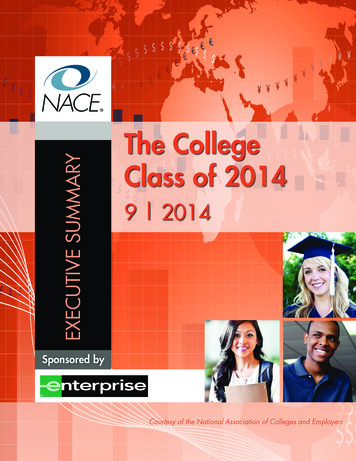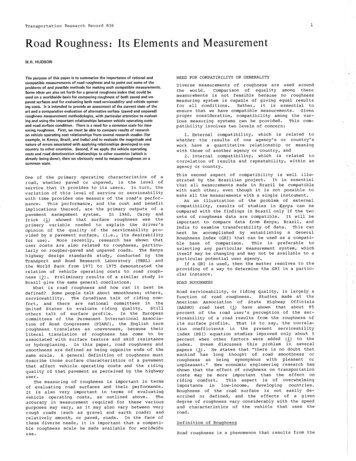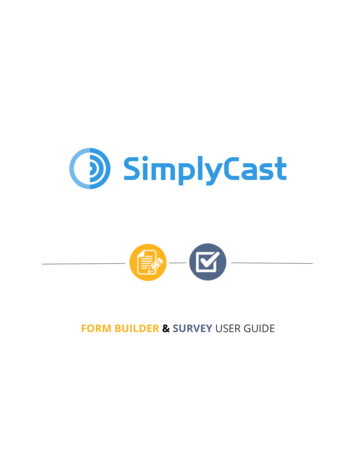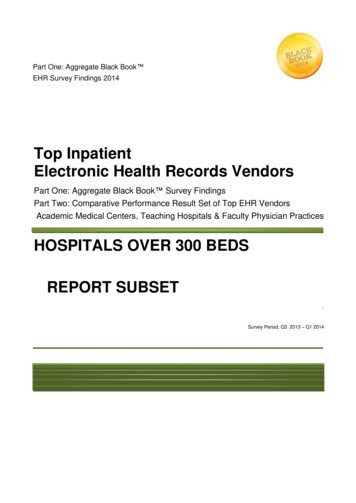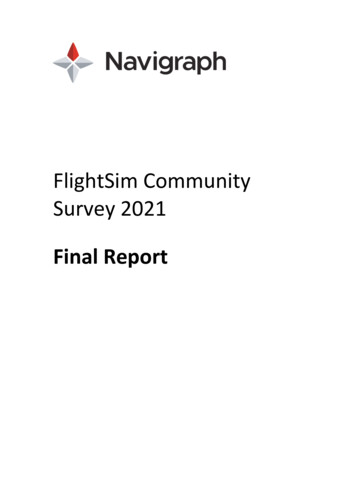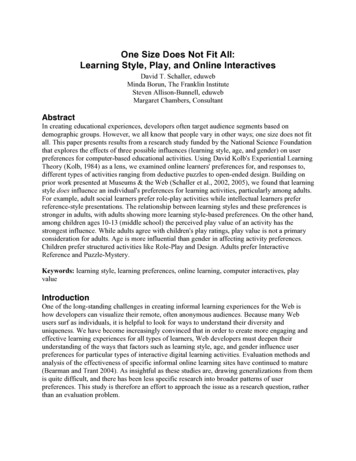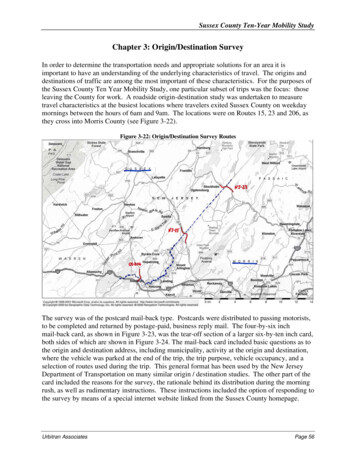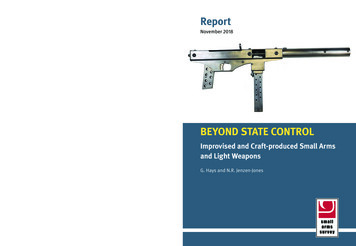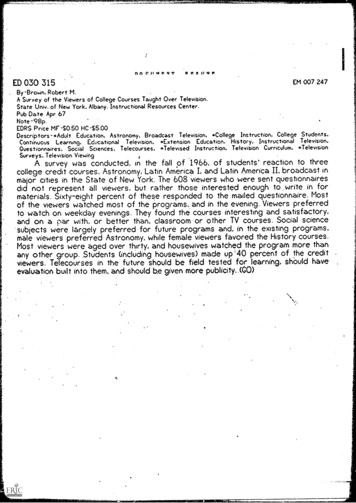
Transcription
ciimit,47.R P!IIMEM 007 247ED 030 315By-Brown. Robert M.A Survey of the Viewers of College Courses Taught Over Television.State Univ. of New York, Albany. Instructional Resources Center.Pub Date Apr 67Note -98p.EDRS Price MF - 0.50 HC - 5.00Descriptors -*Adult Education. Astronomy. Broadcast Television. *College Instruction. College Students.Continuous Learning. Educational Television. *Extension Education. History, Instructional Television.Questionnaires, Social Sciences. Telecourses. *Televised Instruction. Television Curriculum. *TelevisionSurveys. Television Viewing4A survey was conducted. in the fall of 1966, of students' reaction to threecollege credit courses, Astronomy. Latin America I. and Latin America IL broadcast inmajor cities in the State of New York. The 608 viewers who were sent questionnairesdid not represent all viewers, but rather those interested enough to write in formaterials. Sixty-eight percent of these responded to the mailed questionnaire. Mostof the viewers watched most of the programs, and in the evening. Viewers preferredto watch on weekday evenings. They found the courses interesting and satisfactory.and on a par with, or better than, classroom or other TV courses. Social sciencesubjects were largely preferred for future programs and. in the existing programs.male viewers preferred Astronomy. while female viewers favored the History courses.Most viewers were aged over thirty, and housewives watched the program more thanany other group. Students (including housewives) made up '40 percent of the creditviewers. Telecourses in the future should be field tested for learning, shOuld haveevaluation built into them, and should b,e given more publicity.(CO)
APRIL 1967STATE UNIVERSITY OF NEW YORK AT ALBANYINSTRUCTIONAL RESOURCES CENTERROBERT M. BROWNBYCourses Taught Over TelevisionA Survey of the Viewers of CollegeEDO 30315
E1A 0072q7April, 1967STATE UNIVERSITY OF NEW YORK AT ALBANYINSTRUCTIONAL RESOURCES CENTERPOSITION OR POLICY.STATED DO NOT NECESSARILY REPRESENT OFFICIAL OFFICE OF EDUCATIONPERSON OR ORGANIZATION ORIGINATING IT. POINTS Of VIEW OR OPINIONSTHIS DOCUMENT HAS BEEN REPRODUCED EXACTLY AS RECEIVED FROM THEOFFICE OF EDUCATIONU.S. DEPARTMENT Of HEALTH, EDUCATION & WELFARERobert M. BrownByCOURSES TAUGHT OVER TELEVISIONA SURVEY OF THE VIEWERS OF COLLEGE
91APPENDIXaFINDINGS875SUMMARYCONCLUSIONS AND IMPLICATIONS1INTRODUCTIONTABLE OF CONTENTS
The television survey was based on aThis survey was done to-The questionnaires were sent out in early nesreemhpr 1966 and 68 percent of U.:inn*See Appendix for GeneseoOswegoOnondagaNew YorkPERCENT RETURNEDMAILEDRETURNEDQUEST.ONNAIRE DISTRIBUTION.LOCATIONTABLE ITable I shows the returns from the areas.were returned by January, 1967, which is a very good response to a mailed questionnaire.materials.represent all the viewers, but rather those who were interested enough to write in for theThese do notIt was revised in the Fall of 1966 and sent out to 608 viewerswho had either registered for the course or had written in for the syllabus.with over 300 viewers.York.* Produced in the.Spring of 1966, the questionnaire was field tested at that timequestionnaire developed by the Instructional Resources Center at State University of iiewobtain the students' reaction to the courses.Latin America II were broadcast in major cities in the state.In the fall of 1966 three college credit courses, Astronomyt Latin America I andINTRODUCTION
New York accounted for only 5 percent of the credit students*Ober, B. H., Measuring Television Audience, A. C. Nielsen Co., New York, 12 pp.reprint for Mediascope Magazine. A sample size of 300 is used to get an estimateof the audience of programs in the Chicago area (P. 3).sample is only 413 viewers.*approximately 313,000 pupils in college or about 2 percent of the population, and ourIn 1960 there wereThe results did not consider correlations orstatistical differences as this was outside the scope of the study.of the potential viewers in the state.It is not a representative sample of the total viewers, and is not a representative sampleThe survey covers only those who registered and watched or wrote in for the syllabus.the base for credit students in Astronomy for Question Number 4 is 95.For example,This base varies from question to ques-tion depending on the number of students who answered the particular question.credit students in Astronomy for Question Number 1.represents 100 percent of the credit students and 143 represents 100 percent of the non-That is, 97For example, the base for credit students inAstronomy in Question Number 1 is 97 while the base for non-credit is 143.comparison is given at the top of the chart.The questionnaire is tabulated on a percentage basis for comparison, but the base forbut a quarter of the non-credit students.supplying another quarter.(from Question Number 3) accounted for almost half of the credit students, with BuffaloAlbanyHowever,numerically, Albany, Buffalo, and New York account for two-thirds of all responses.tively, and the lowest from New York at 52 percent, and Albany at 62 percent.The highest returns were from Buffalo and Oswego at 85 percent and 81 percent respec--2-
Same DistributionUnder 40SexAgeThat is, it concentrates onOver 40Same DistributionProfessionalgard to age, school level and occupation as shown in Table III.The various areas within the state did not seem to vary significantly with re-the largest groups within the state or sample and not the average or median.This chart is based on the mode for simplicity.SkilledOccupationBeyond High SchoolSAMPLESTATEWIDE AND QUESTIONNAIRE SAMPLEHigh SchoolSTATESOCIO-ECONOMIC COMPARISONEducational LevelFOR COMPARISONTABLE IITable II shows a comparison of the sample with the general population of the state.
10.511.011.310.8BuffaloRochester(Inc. Brockport)Syracuse(Inc. Oswego,Onondaga)New 045444636%OTHER37-45No Entry37-4332-37 yearsNo EntryAGE MODEDetails of*U. S. Bureau of the Census, Census of Population, 1960Vol. I, Characteristics of Population, Part 34 ABCD,U. S. Government Printing Office, Washington, D.C., 1963charts.the samples' age, occupation, and other characteristics are given in the followingpeople than the state as a whole or any large, identifiable urban area.In brief, the sample was better educated, older, and contained more professional10.9 yearsAlbanyLOCATIONCHARACTERISTICS OF SELECTED STATE*AREASYEARS OFSCHOOL COMPLETEDTABLE III
11.10.9.8.7.6.5.4.receive the syllabus?you register for the course and/orregistered in Albany.percent of the credit viewerspercent in Buffalo.percent in New York City.to, the other courses you have taken,How do these television lessons compareeither by television or in the classroom?other televisionThe courses were the same or better than classroom orcourses.5How would you describe the presentation of this course?The courses were interesting.How would you describe the content of this course?Most viewers were satisfied with the courses.Did you buy the textbooks(s) for this television course?Credit viewers bought the textbooks.this television course?Was the textbook helpful in learning the material inThe textbook was helpful.view television lessons?what times would be the most convenient for you toon a weekday evening.Viewers preferred to watch the television programsin the television courses?How helpful was the syllabus in learning the materialThe syllabus was helpful in the courses.courses?Did you take notes while viewing these televisionstudentsmostof the time.Notes were taken by most of theWhere did48255When did you view the television lessons?Most viewers watched in the evening.2.3.How many of the television lessons did you view?Most of the viewers watched most of the programs.1.and theThirty-one points were covered in the questionnaireinformation isresults are summarized below. More detailedcontained in the text.SUMMARY
When did you last take a college course other than this particular televisioncourse?The courses were viewed by those still in college or out for more thanfour years.In what way(s) ars you presently continuing your higher education other thanthis televisibn course?About a third of those continuing their education plan to do it bytelevision.If you are not now continuing your higher education, in what way(s) do you planto do so?Two-thirds of those who plan to continue their education will do it bytelevision.What type of course do you want on television?Credit courses mainly undergraduate were most wanted by viewers.How often woald you be willing to attend a class meeting at a local college toobtain extra credit in a television course?Credit viewers will attend a meeting a week for extra credit.What is your objective(s) in continuing your higher education?Credit vlewers want a degree, non-credit viewers want enrichment.Will further courses on television help you to achieve this goal?Most viewers felt television will help them obtain their goal.How did you find out about this television course?The largest number of vlewers learned of the course through the newspaper.What program(s) in this television course did you like best and why?Many of the viewers liked all the programs.Which program(s) in this television course did you like least and why?Dullness and disorganization were liked least by viewers.14.15.16.17.18.19.20.21.22.lesson.If you watched repeat broadcasts of these television lessons, why did youdo so?Repeat lessons were watched equally to either review or make up a13.12.
What comments describe your feelings about learning via television?Viewers liked the convenience of television.Comments:What course were you registered in?Astronomy had the most registrations.Were you a credit or non-credit viewer?Most viewers were non-credit.What is your highest educational level?College students or those aspiring to be so were three quarters of theviewers.What is the sex of viewers?Males tended to take Astronomy and females the History courses.What is the age of viewers?Most viewers were over 30.What is the occupation of viewers?More housewives watched the courses than any other occupational group.24.25.26.27.28.29.30.31.Television courses are not too bad after all.What subjects would you like to see on future television courses?The social science subjects were preferred by future televisionviewers.23.
This question had four alternatives from which the respondents could choose.HOW MANY TELEVISION LESSONS DID YOU VIEW?A combination ofCredit students accounted for only five per cent of those not completingcourse.In Latin America II the completions increase to 96 percentwhile in Astronomy they decrease to 87 percent for the credit students.have completed the course.the coursevand 75 percent of the non-credit students viewed sufficient programs toThus, 90 percent of the credit students viewed enough programs to have completedthe course based on the total group.Non-credit students accounted for 15 percent of those not completing thecourse.group that 80 percent of the students watched enough programs to have completed thecategories three, "Most of Them", and four, "All of Them", indicates on the compositestudents who watched half or fewer than half of the programs.The composite chart when combined this way gives a total of 20 percent of theless."About Half", we can see that these viewers watched about half of the programs orIf, however, we combine alternative number one, "First Few", and alternative two,ill
,ALL 11111431621145fo-76325355WI18VII111BASE 100% 1414LATIN AMERICA I.BASE 100% INCc1162%1143BASE 100% I97BASE 100% IIBASE 100% BASE 100% 214541481422107452924LATIN AMERICA IINCCHOW MANY TELEVISION LESSONS DID YOU VIEW?111111111111111111111111111InIIBASE 100% BASE 100% 25405o501778370-2 /48NCc11111116 15MIMI202911111H113 10MI25in31149137%C NCBASE 100% 1413COMPOSITENC - NON-CREDIT165AVERAGEKEY:C - CREDIT1
On a composite basis, that is, a percentage computed on the entire response,WHEN DID YOU VIEW THE TELEVISION LESSONS?However, in repeated showings, the law of diminishing returns seems toA weekday was preferredThe best morning hours were 7 to 9, the best afternoon 12 to 1, and the bestwatched in the evening ,20 percent in the morning, and 10 percent in the afternoon.By proportionately dividing "at different times" it is estimated tht 70 percentwith the next best time 9 to 11 in the evening, and finally 7 to 9 in the morning.A combination of question 2 and 5 indicates the best time is 6 to 8 in the evening,evening 6 to 8.Sunday.by 81 percent of the students, with 8 percent favoring Saturday and 11 percent favoringthe most convenient for you to view the television lessons?".This question is closely related to number five which asks "What time would bein the afternoon and 16 percent at various times.operate, with 58 percent viewing in the evening, 17 percent in the morning, 8 percentevening.while only 28 percent of credit students for Latin America II viewed it in thepercent of the non-credit Astronomy students viewed the course in the evening,This varies from course to course and from credit to non-credit student.75A morningshowing and an evening showing would account for 75 percent of the viewers.morning, 16 percent at different times and 9 percent in the afternoon.58 percent of the group viewed the programs in the evening; 17 percent in the#2-10-
918111111111H11111111111 40521242830%NC146 NC BASE 100% 80BASE 100% 16%CBASE 100% 44C102LATIN AMERICA IIH11111111111111I1111111WUBASE 100% BASE 10070 19413628262419im11111111111111111In11111BASE 100% 31 NC7%BASE 10070 111111COMPOSITENC - NON-CREDITC - CREDIT142059541081718 %8311122III70'86361111111111101658917%171 C BASE 100% 428C NC257 NCAVERAGEKEY:C25LATIN AMERICA IIWHEN DID YOU VIEW THE TELEVISION LESSONS?ASTRONOMY2BASE 100% DIFFERENT111TIMESEVENINGNOONAFTER -MORNINGCATEGORYQUESTION NUMBERRESPONSE IN PERCENT TO
ASE 1001* 134BASE 100% iiMillill.00111113147I04116162516';I8IN7MIN0 1020 10IN211102030%C BASE 100% 398C NCNC48%MIUMBIN111111COMPOSITENC -NON-CREDIT110396746AVERAGEKEY-.C BASE 100% 163NC BASE 100% 23533%LATINAMERICAHC BASE WM 2273 NC BASE 100% 2844111470%C BASE 100% NC BASE 100% LATINAMERICA IWHERE DID YOU REGISTER FOR THE COURSE AND/ORRECEIVE THE SYLLABUS?C -CREDff
NEW YORKONONDAGA2651662 1411112 911111611The composit portion of the chart indicates that Albany and Buffalo accounted"WHERE DID YOU REGISTER FOR THE COURSE AND/OR RECEIVE THE This may be indicative of the amount of local advertising.For example,Perhaps this is a reflection not only of local advertising, but alsoThis, of course, is way out of proportion to the populationlocal effort on the part of school officials or advisors.of the area.of all credit students.Albany accounted for 70 percent of the credit students in Astronomy, and 48 percenttotal.for 50 percent of all viewers with Albany alone accounting for 30 percent of the131111111111I111111
,1111111111111BASE 100% MOSTOF THETIMEFAIRLYOFTEN,111110IliC '3ASE100% 000h 3111111111143741486111111111PHI111111191360%28 NC BASE 100% 23 C BASE100% LATINAMERICAII71 NC BASE 100% 42 cLATINAMERICA I132 NC BASE 100% 95IDID YOU TAKE NOTES WHILE VIEWING THESETELEVISION COURSES?ASTROMDMY4BASE100% OCCASIONALLYIIIIWRARELYCATEGORYQUESTION 111181111150101525%C-1-NC106 C BASE 100% 391COMPOSITENC -NON-CREDITC -CREDIT.1
The conclusion drawn from this chart is that most of the credit studentsDID YOU TAKE NOTES WHILE VIEWING THESE TELEVISION COURSES?With regard to notetaking, an interesting sidelight seemed to bealthough scientific names did not appear to be a problem in Astronomy.that students in Latin America I and II had difficulty with Spanish names,took notes.took notes most of the time, while only about a third of the non-credit students#4
There were multiple answers on this question, but it was clearly indicatedWHAT TIMES WOULD BE THE MOST CONVENIENT FOR YOU TO VIEW TELEVISION LESSONS?The.next best time is 8 to 10.The mornings were preferred byTeachers commentedThe afternoons were preferred by 22% of the respondents, and the bestQuestion Number 5 is an opinion or preference question, while Number2 is a historical question showina what the students actually did.afternoon.However, question two indicated that only 9 percent actually viewed in thetime was from 12 to 1.schedules.that 8:00 a.m. was not a good time for them to view due to their classroomalthough, the entire period of 7-9 seemed to be convenient.25 percent of the respondents, with most of them preferring the hours 8 to 9,hours 6 to 8.The evenings were preferred by 53 percent, with most of them preferring thethat weekdays were preferred by 81 percent of the viewers.#5-16-
613%15%10-1111-12Base 100% - 46517%8-912%2-315%9-10Base 100% - 19219%7-817%1-235%8-9Base 100% - 22325%6-722%12-1Ever 21-1n22%Afternoon22%AFTERNOONBase 100% - 38025%MORNING7-8Base 100% - 36011%8%SATURDAYSUNDAY81%WEEKDAY#5 WHAT TIMES WOULD BE THE MOST CONVENIENT FOR YOU TO VIEW TELEVISION LESSONS?
This isThis numberThis indicates that this particular syllabus probably needs revising.is more than three times that of Latin America I and four times that of Astronomy.credit students did not find the syllabus helpful in Latin America II.However, 16 percent of theSome ninety-four percent of the students found the syllabus helpful,HOW HELPFUL WAS THE SYLLABUS IN LEARNING THE MATERIAL IN THE TELEVISION COURSE?particularly evident in Astronomy and Latin America I.#6
NOTHELPFULHELPFULCATEGORYASTRONOMY6NCEMSE 1W104 N569594%NC-C NC3963II393655mommitilmilimullC BASE 100% IIUIuhIIIuhuIIIIlHhIIII25 NC BASE 100% HimCOMPOSITENC -NON-CREDITC -CREDIT166230AVERAGEKEY:26 C EMSE 10Vo IIIIIIIIIMMilliddrnBASE 100% 68 Nc95%BASE 100% LATIN AMERICA II44C9411111111MIIIIIII11IMIIIBASE 100% BASE 100% UUM4 AMEMCA IHOW HELPFUL WAS THE SYLLABUS IN LEARNING THEMATERIAL IN THE TELEVISION COURSE?96BASE WM QUESTION NUMBERRESPONSE IN PERCENT TO1se
90 percent of the credit students purchased the textbook."DID YOU BUY THE TEXTBOOK(S) FOR THIS TELEVISION LESSON?"basis.suggested that college bookstores handle the text on a mail orderSomeApproximately 60percent of the non-credit students did not obtain the text.the book or obtained it by some other means.Incidental commentsfhowever, indicated that some students borrowed#7
INOYESCATEGORY111111111111111111611039NCBASE 100% 14545511111111111111111111111111111196 %BASE 100% 89 %23 C11111159104190 %436Immum3624Jufl !-C NC4060%COMPOSITENC -NON-CREDITC - CREDIT164 C BASE 100% 408244 NCAVERAGE29 NC BASE 100% BASE 100% LATIN AMERICA IIKEY.76 NC BASE 100% 44 CI1IflflUJIIiIIIIII 6211111111111BASE 100% BASE 100% LATIN AMERICA IDID YOU BUY THE TEXTBOOK FOR THISTELEVISION COURSE?ASTRONOMY7BASE 100% QUESTION NUMBERRESPONSE IN PERCENT TO
Non-credit students who.4,bought the book found the text more helpful than credit students.mainly non-credit students who did not procure a text.only about two-thirds of the viewers answered this; these who did not answer wereHowever,95% of the viewers found the textbook helpful in all the courses, although"WAS THE TEXTBOOK HELPFUL IN LEARNING THE MATERIAL IN THE TELEVISION COURSE?"11 percent of the credit astronomy students did not find the book helpful.#8
NOYESCATEGORYBASE 100% 34 NC11411M3- 2 3 -11111111111111111111111111111 1111111111111111111a6111111111111111111196BASE 100% C4416 3 C1 18 NC1 7NC BASE 100% AVERAGE111111BASE 100% C NC2 81COMPOSITENC -NON-CREDIT2 4 C BASE 100% LATIN AMERICA IIKEY:C - 111.111.1111111611111 1.11111111/111111.111"111.111111.1111.111111411 6.411.111111111111197418BASE 100% 6 7 NCBASE 100% .11.111111111.1"BASE 100% CLATIN AMERICA I95ASTRONOMY8WAS THE TEXTBOOK HELPFUL IN LEARNING THEMATERIAL IN THIS TELEVISION COURSE?BAsE 10004 QUESTION NUMBERRESPONSE IN PERCENT TO-
The students areThis does not mean that the course should be "diluted", rather thelearning rather than teaching.same content should be "programmed" by response systems and organized aroundstudent.understandable to theto evaluate and readjust the lessons so they are morePerhaps a sampling of tapes can be made with a student response systembetter organized than the others and used many more resources.Astronomy wasIt was the organization,has to be extremely well organized to be effective.not the content, which made the difference in difficulty.A television courseand the instructor, as well as resource facilities.Success in a regular course depends on contact with other studentsscattered, having little contact with the instructor and other students.which in a sense merely stimulate classroom teaching.The difficulty seems to be in the organization of the coursesto 27 percent of Latin America I and 38 percent for Latin America II.The percentage of students who found the course "too hard" increasedcourse was considered "too hard" by 20 percent of the credit students.The AstronomyMost of the non-credit students felt the course was "just right"."HOW WOULD YOU DESCRIBE THE CONTENT OF THIS COURSE?"The credit students did not agree with this judgment.#9-24-
25 NC BASE 100% 24 C BASE.10070 , 1-25-044:01MUI111111COMPOSITENC -NON-CREDIT524 %6727823i1H2710N155046IIIIIIIIIIIIIII313 %77169 C BASE100% 408C NC239 NCAVERAGEKEY:C - CREDITIIIHIIIIMIIIIIIIIIAtIM IIIHUllhIUhIflIflhIIII 85BASE 100% 70 NC71BASE100% LATIN AMERICA IIC4428067BASE 100% BASE100X 2IIIIIIIIIIIIIIIIIMIllIiNCBASE Klin 14420%CLATIN AMERICA IHOW WOULD YOU DESCRIBE THE CONTENT OF THISCOURSE?ASTRONOMY9BASE100% 101QUESTION NUMBERRESPONSE IN PERCENT TO
Ine students tnr the mGst part thought that the courses were interesting.HOW WOULD YOU DESCRIBE THE PRESENTATION OF THIS COURSF?'1not only interested in but stimulated by the courses.,percent of the non.-ciedit students and 89 pczcent of the credit students wereIf the csAtegory interesting is combined with the category stimulating then 95#10-2b-
98I1111STIMULATING11111111113411211%BASE-100A 14 8BASE 1000h TION NUMBERRESPONSE IN PERCENT TO6478111111125111111111111101M1176880NC82NC BASE 100% 9%C45BASE 100% CLATIN AMERICA I489111111122371111111111111111M 69111 5%1111111111111111COMPOSITENC -NON-CREDIT30155657411t295G7%C NC4024MIIIIIMI 6 91811111113II170 C BASE 100% 432262 NC1111111111111111111ii111113 2 NC BASE 100% BASE 100% BASE 100% 27CAVERAGEKEY.BASE 100% LATIN AMERICA IIHOW WOULD YOU DESCRIBE THE PRESENTATION OFTHIS COURSE?C - CREDIT
If the category "difficult to compare" is proportionately divided,regular instruction.then it is estimated that 89 percent felt the courses were the same or better thandifficult tc compare.same or better, while 37 petcent felt it wasThe television courses seem better than or equal to regular courses; 56 percentHOW DO THESE TELEVISION COURSES COMPARE TO OTHER COURSES YOU HAVE TAKEN,EITHER BY TELEVISION OR IN THE CLASSROOM?of the students felt they were about#11
01111111111111111BASE100%- IIIMIK28312919%94 C BASE 100% BASE 100% 140 NC BASE 100% 254191038232826%6539LATINAMERICA INCC11111111111111111111111111111HBASE 100% BASE 100/0 CBASE 100% 111111COMPOSITENC -NON-CREDITC -CREDIT334261031273021%18173II2011111141111111 198III3773026%158 C BASE 100% 3 9 3235 NCC NCAVERAGEKEY:3 0 NC BASE 100/0 25LATINAMERICAIIHOW DO THESE TELEVISION LESSONS COMPARE TO THEOTHER COURSES YOU HAVE TAKEN, EITHER BYTELEVISION OR IN THE THESAMEBETTERTHANCATEGORYQUESTION NUMBER11RESPONSE IN PERCENT TO
This fact tends to support question 9 wherein New York City.repeat broadcasts.Only half the students indicated, however, that they watchedIt should also be noted that repeat broadcasts were not availablehad tO watch it twice.the students commented that Latin America II was too difficult and consequently, theystudents watched to'review the lessons.However, in Latin America II, the creditThe credit students watched repeat broadcasts to make up lessons, while theIF YOU WATCHED REPEAT BROADCASTS OF THE TELEVISION LESSONS, WHY DID YOU DO SO?non-credit students reviewed the lessons.#12
11iBASE100% C BASE100% 4611111111H111159431111111111111111160 %COMPOSITE111111I,182531MIMI261111111149siftC NCC BASE100% 21617 NC BASE100% 124 NC24INC -NON-CREDIT38%NC BASE100% CLATINAMERICA IIKEY:C -CREDIT55%5354 NC BASE100% BASE10ft ,22BASE100% C46LATIN AMERICA II.EYOU WATCHED REPEAT BROADCASTS OF THETELEVISION LESSONS, WHY DID YOU DO SO?BASE1MA ASTRONOMY12iminmilmil-tO REVIEWA LESSONLESSONTO MAKEUP ACATEGORYQUESTION NUMBERRESPONSE IN PERCENT TO,
61 percent of the students had taken a course within the last year.WHEN DID YOU LAST TAKE A COLLEGE COURSE OTHER THAN THIS ONE?The nextThe television lessons primarily attracted those still in college ratherfirst' college course.It is interesting to note that for 20 percent of the viewers this TV course was theirthan those out of c011ege quite some time and those who never had a college course.20 percent.highest category was more than 4 years ago with 27 percent, followed by never, with413-32-
111111IINEVER1111111THAN 4YEARS AG HIIIIHIHIMORE4 YEARSWITHINTHE BASE 100% 231835219211111IH11111111III11111111111111.,BASE 100% BASE 100 ' INCC198332171315426CbASE 100% 3221511111112II3III251111C BASE 100% 235 NC61 T.1111111C i NC20276938k397COMPOSITENC-NON-CREDITC -CREDIT162AVERAGEKEY:NC LASE10070 54%2724LA1IN AMERICA li1122481.7344I ATIN AMERICA IBASE 100% 521r 91NC335BASE 100% cASTRONOMY13WHEN DID YOU LAST TAKE A COLLLGE COURSE OTHERTHAN THI5: r/TTTCULAR TELEVISION COURSE?BASE um 94WITHINTHE LAST .2 YEARS I.YEARWITHINTHE LASTCATEGORYQUESTION NUMBERRESPONSE IN PERCENT TO
basis.was the large percentage of full time students taking Latin America II on a non-creditOne of the most notewOrthy observancesSome 48 percent of the viewers were not continuing their education, while 38 percentIN WHAT WAYS ARE YOU PRESENTLY CONTINUING YOUR HIGHER EDUCATION OTHER THAN THISTELEVISION COURSE?were continuing as a full or part-time student.#14A
NCBASE 100% 137AS ASTUDENTNON CREDITIHI1PART-TIME liiiCREDITTUDENT .S ASE 100% 1111111piMEH11111111111111111C -CREDIT22512306286027%235 %BASE 100% 3 99COMPOSITENC -NON-CREDIT16 4AVERAGEKEY:2 8 NC BASE lom 2510H1BASE 100% Nc BASE 100% c56146%704336211111111111111111BASE 100% BASE 100% LATIN AMERICA II2141971111111111111111116 017%CLATIN AMERICA IIN WHAT WAYS ARE YOU PRESENTLY CONTINUINGYOUR HIGHER EDUCATION OTHER THAN THISTELEVISION COURSE?96ATIMMIOMY14ABASE 10040/0 S ASTUDENTFULL TIME11REDITOT NOWONTINUINGCATEGORYQUESTION NUMBERRESPONSE IN PERCENT TOC NC
#14Bpercent of the students.continuing by television.Correspondence courses were taken by only 4percent were taking courses at local institutions and 29 percent wereOf those who indicated they were continuing their education/ 67HOW ARE YOU PRESENTLY CONTINUING YOUR HIGHER EDUCATION?
111111-903365853BASE 100% 1111111111H111183ASTRONOMYBASE 100% QUESTION NUMBER14BRESPONSE IN PERCENT 8%0-11111111111HIC11 NC190475014250%36 NC BASE 100% BASE 100% BASE 100% C28LATIN AMERICA IIBASE 100% LATIN AMERICA IHOW ARE YOU PRESENTLY CONTINUING YOURHIGHER EDUCATION?.130Iii111111111111W 111111111111BASE 100% 1 05BASE 100% AVERAGEKEY:9040215111 1844I2342967%C NC23 51111111BASE 100% 11111.79%NCC111111COMPOSITENC -NON-CREDITC - CREDIT,I
#15A11.1141. 1.111.111N1111nwwnww.,Only 8 percent will continue as full timeAbout half the viewers answered this question.their education on a non-credit basis.45 percent of the non-credit students said they would continuecredit students and 38 percent will continue on a part-time basis.stay out of school.For those not now continuing their education, 17 percent willWAYS DO YOU PLAN TO DO SO?IF YOU ARE NOT NOW CONTINUING YOUR HIGHER EDUCATION, IN WHAT-38-
251111111111111101111111 221111110%4836644iM1111111111111111111111 381115IHIll 164%93 NC BASE 100% BASE 100% BASE 1007o 22 C4577BASE 100% 56 NC91111111111111MMMI091111111 260%BASE 100% C638219 NC11LATIN AMERICA IIC26LATIN AMERICA IKEY:26IIIIIHIIIH141111111111111111221111111 222645168BASE 100% 2%590C - CREDIT72NCC,11111118IIIII171 3611111111H119 1962II1 16111113837BASE 100% C NC227COMPOSITENC - NON-CREDITBASE 100% AVERAGEIF YOU ARE NOT NOW CONTINUING YOUR HIGHEREDUCATION , IN WHAT WAY ( S) TO YOU PLAN TO DO SO? "ASTRONOMY15ABASE 100% NONCRED TSTUDENTAS ACREDITAS ASTUDENTPART TICREDITFULL TISTUDE
Table II shows a comparison of the sample with the general population of the state. TABLE IISOCIO-ECONOMIC COMPARISON STATEWIDE AND QUESTIONNAIRE SAMPLE. FOR COMPARISON. STATE SAMPLE. Educational Level High School Beyond High School Occupation Skilled Professional Sex

